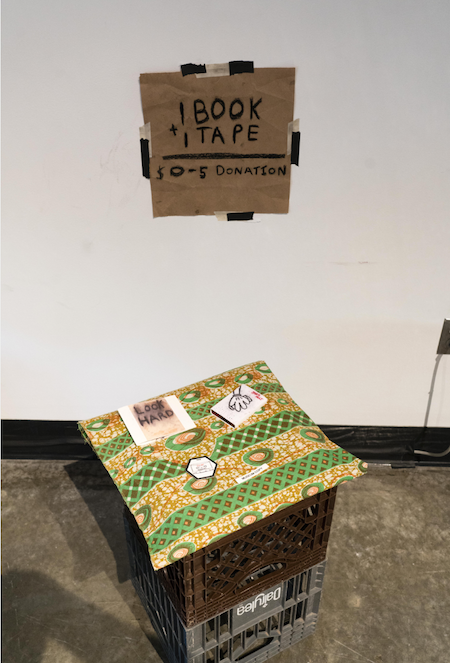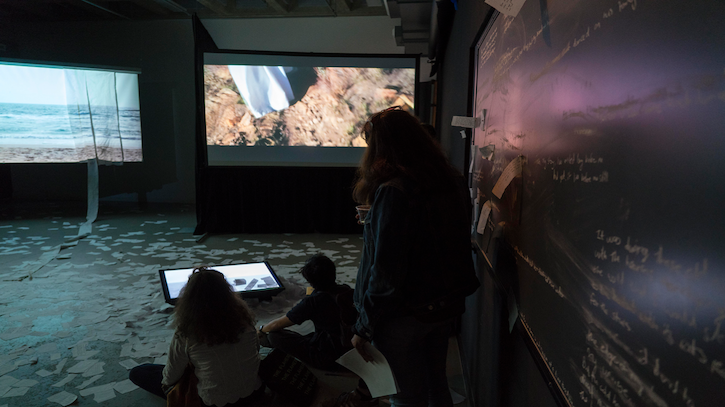Ways of Organizing: “What’s Good Is Not What’s Really Good”
Greg De Cuir Jr.
I am naturally drawn to convergences in nonfiction cinema. It takes a lot to move me if it is packaged in a conventional form. As such, my curating automatically leans toward the creative fringe in documentary, I do not often work with traditional documentary. Even when I was selecting for the international competition section of a large film festival, that festival was explicitly geared toward creative documentary. I think that actually says more, that festivals now commonly identify themselves as interested in creative documentaries before any other type. This is driving the standard in the field.
In a specific example from the Flaherty Seminar 2018, one of our featured artists presented herself to me as someone who experiments with performance in addition to video. I kept that in mind as I was researching her work and when the opportunity arose to screen something that included a performative element, I asked her if she would like to execute a performance in the cinema space, right in front of the screen during the show. She had never done this before but was up to the challenge. The idea was to do something akin to “expanded cinema,” but expanding the body on-screen outward to a body among the audience. Lately I have been experimenting with performance a lot in my cinema programs. Not only do I want to challenge boundaries and give my audiences an additional artistic “attraction” when they sit for a cinematic experience, but I also want to challenge myself as a curator and push into an interdisciplinary practice whenever I can.
I like to make my intervention into the politics of curating and spectatorship. It is about finding the necessary voices, and seeing the necessary images. One of my favorite quotes that I come back to often, by Dziga Vertov, is “What’s good is not what’s really good, only that which is profitable to be considered as such.” My work is about marking these differences. It is also important for me to empower the audiences and the artists that I work with. Ideally my invitations come with an open call for self-expression, ultimately to create a space where learning and understanding can take place.
 Photo by Robert Goodman, courtesy of The Flaherty.
Photo by Robert Goodman, courtesy of The Flaherty.
I am always concerned with the ethics of what I do. Not because of gatekeeping, more so because of politics. Volume means little to me, other than that I accept the fact that time is short and I can only watch a fraction of the great work that exists in the world. For me the politics of curating revolves around who I show, and what those artists focus their lens on. I feel we are certainly past the moment where we can be blind to gender concerns, so including work by women is always on my mind when I assemble programs. I am also sensitive to work that comes from underrepresented areas on the global-cinematic map. I consider myself less of a gatekeeper and more on the side of those who want to blow that gate off of its hinges. Therefore I respond to my role as someone who practices activist curating.
Whether there is a surge or not, I think the responsibility remains the same. When there were less films and videos being made, one still had to exercise an ethics of selecting and presenting. That means an ethics of researching. A good curator has to be a good researcher. If one is not prepared for that then one is not responding properly to the role.
****
Funding plays a role in the types of programs I can organize, but it is not the ultimate determining factor. I will get my programs done somehow. It is only a question of when and where. Funding often conditions the scope. Maybe I can show more, or assemble the best quality prints, or invite high-profile guests. Still, the most creative and interesting programs seem to be the ones that are generated by enthusiasm more than economics. It is the rare occurrence that there is enough funding for a lot of the programs one would want to organize. As a result, my default operating procedure is to assume that there is little to no money available for what I want to do. This is the point in which creativity emerges.
Normally I am working with nonprofit cultural institutions for my funding needs, also embassies and other representative bodies. I rely a lot on state funding and ministries of culture in various countries as well. They all have their own politics and their own needs. However, it doesn’t take long to identify the funding bodies that are easy and productive to work with. I am always researching new funding institutions, based on the project and the artists involved. This is one of the most difficult parts of the work, though I am sure it is just as difficult to be on the other side of the table and to have to decide on the few that get awarded out of the many great projects that are proposed on a yearly basis.
****
Developing audiences is always a concern, but it is probably the thing that I have the least amount of time and resources for. I tend to rely on the built-in audiences at whatever institution I am collaborating with, and hopefully affect those audiences and expose them to something new and exciting. Of course my programs must be molded to the contexts of the spaces in which they are shown. That has material concerns, in terms of what formats I can show, and also political concerns, in terms of the explicit and implicit stances of the institutions and also the audiences that they serve. It is generally a good thing to challenge audiences, just as it is generally a bad thing to talk down to them. Institutions that are sensitive to this dynamic are the best to work with, regardless of what sort of budget they can offer.
I think it is difficult to be a good developer of audiences if one is working independently. With an institutional job comes the possibility to become familiar with an audience, and learn how to build that audience. I don’t really develop audiences. It is probably more likely that I develop contexts.
****
 Photo by Robert Goodman courtesy of The Flaherty.
Photo by Robert Goodman courtesy of The Flaherty.
Going back to the Flaherty Seminar, my most recent project and a great case study, I think my co-selector (Kevin Jerome Everson) and I focused on intervening in political and cultural arrangements specifically. We wanted to respond to what we had seen—or what was missing—in the previous year’s Seminar, even if we did not make that explicit to our audience. So it became a question of showing artists who might not have normally been given a seat at the table. That was a political gesture. In terms of the culture of the Seminar, we wanted to open things up beyond the cinema space and into a gallery space. We also wanted to change the viewing culture and habits that have built up over the years, such as the length and format of programs. That cultural shift was apparent immediately, because some of the longtime participants of the Seminar felt the need to express to us that they were uneasy about the new rhythm they had to adjust to. They eventually did adjust though, and we were happy that our intervention was felt, no matter if it was successful or not. It was satisfying to push people out of their comfort zone. We should come to art in an open manner, to be challenged, not to be reassured that the world is safe for us and corresponds to our views. As the great cineaste Dušan Makavejev once wrote, “art should alarm.” Probably curating should too.
Title Image Credit: Photo by Robert Goodman, courtesy of The Flaherty.

